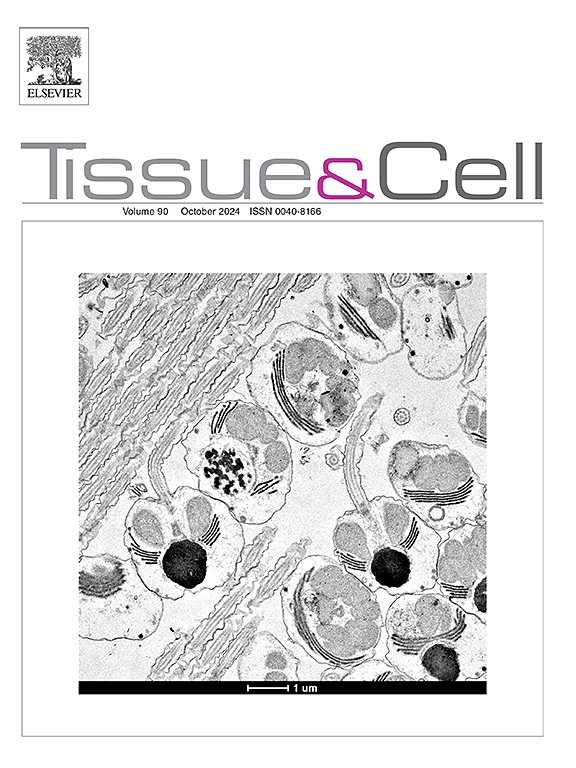Impact of Red and Red/NIR OLEDs photobiomodulation effects towards promoting ADMSCs chondrogenic differentiation
IF 2.7
4区 生物学
Q1 ANATOMY & MORPHOLOGY
引用次数: 0
Abstract
Photobiomodulation (PBM) uses light to stimulate cellular responses and has the potential to enhance cartilage regeneration through mesenchymal stem cell (MSC) differentiation. This study investigates the chondrogenic potential of adipose-derived MSCs (ADMSCs) under PBM using Red (630 nm, 72.7 mW) and Red/NIR (630 nm and 845 nm, 59.7 mW) organic light-emitting diodes (OLEDs), with ADMSCs exposed to two distinct OLED panels (10.85 cm2 surface area each). These wavelengths correspond to the absorption peaks of cytochrome c oxidase (CCO), a key mitochondrial enzyme involved in PBM-induced cellular bioenergetics. Cells were cultured in 24-well cell culture plate, receiving irradiance of 3.6 mW/cm2 and 2.74 mW/cm2, respectively. Exposure durations were 4.5, 14, and 23 minutes for Red OLED and 6, 18, and 30 minutes for Red/NIR OLED, delivering energy doses of 1, 3, and 5 J/cm² at 72-hour intervals. While Red/NIR OLED irradiation significantly enhanced ADMSC proliferation, it did not improve chondrogenic differentiation. In contrast, Red OLEDs consistently outperformed Red/NIR OLEDs as evidenced by stronger Safranin O staining, elevated collagen type II expression, and enhanced glycosaminoglycan (GAG) deposition via Alcian Blue staining. These findings underscore the superior efficacy of Red OLED-mediated PBM in promoting ADMSC differentiation toward the chondrogenic lineage and highlight the critical role of wavelength selection for PBM-based cartilage repair. Further exploration of the underlying mechanisms and optimization of PBM parameters is needed for improved clinical efficacies in tissue engineering and regenerative medicine.
红色和红/近红外oled光生物调节作用对促进ADMSCs软骨分化的影响
光生物调节(PBM)利用光刺激细胞反应,有可能通过间充质干细胞(MSC)分化促进软骨再生。本研究使用红色(630 nm, 72.7 mW)和红色/近红外(630 nm和845 nm, 59.7 mW)有机发光二极管(OLED)研究PBM下脂肪源性间质干细胞(ADMSCs)的成软骨潜能,并将ADMSCs暴露于两个不同的OLED面板(每个面板的表面积为10.85 cm2)。这些波长对应于细胞色素c氧化酶(CCO)的吸收峰,CCO是参与pbm诱导的细胞生物能量学的关键线粒体酶。细胞在24孔细胞培养板中培养,辐照度分别为3.6 mW/cm2和2.74 mW/cm2。红色OLED的暴露时间分别为4.5、14和23 分钟,红色/近红外OLED的暴露时间分别为6、18和30 分钟,以72小时的间隔提供1、3和5 J/cm²的能量剂量。虽然红/近红外OLED照射可显著增强ADMSC增殖,但不能改善软骨分化。相比之下,红色oled的表现一直优于红色/近红外oled,这可以通过更强的红红素O染色、更高的II型胶原表达和阿利新蓝染色增强的糖胺聚糖(GAG)沉积来证明。这些发现强调了Red oled介导的PBM在促进ADMSC向软骨细胞谱系分化方面的卓越功效,并强调了波长选择在PBM软骨修复中的关键作用。为了提高组织工程和再生医学的临床疗效,需要进一步探索PBM的潜在机制和优化参数。
本文章由计算机程序翻译,如有差异,请以英文原文为准。
求助全文
约1分钟内获得全文
求助全文
来源期刊

Tissue & cell
医学-解剖学与形态学
CiteScore
3.90
自引率
0.00%
发文量
234
期刊介绍:
Tissue and Cell is devoted to original research on the organization of cells, subcellular and extracellular components at all levels, including the grouping and interrelations of cells in tissues and organs. The journal encourages submission of ultrastructural studies that provide novel insights into structure, function and physiology of cells and tissues, in health and disease. Bioengineering and stem cells studies focused on the description of morphological and/or histological data are also welcomed.
Studies investigating the effect of compounds and/or substances on structure of cells and tissues are generally outside the scope of this journal. For consideration, studies should contain a clear rationale on the use of (a) given substance(s), have a compelling morphological and structural focus and present novel incremental findings from previous literature.
 求助内容:
求助内容: 应助结果提醒方式:
应助结果提醒方式:


